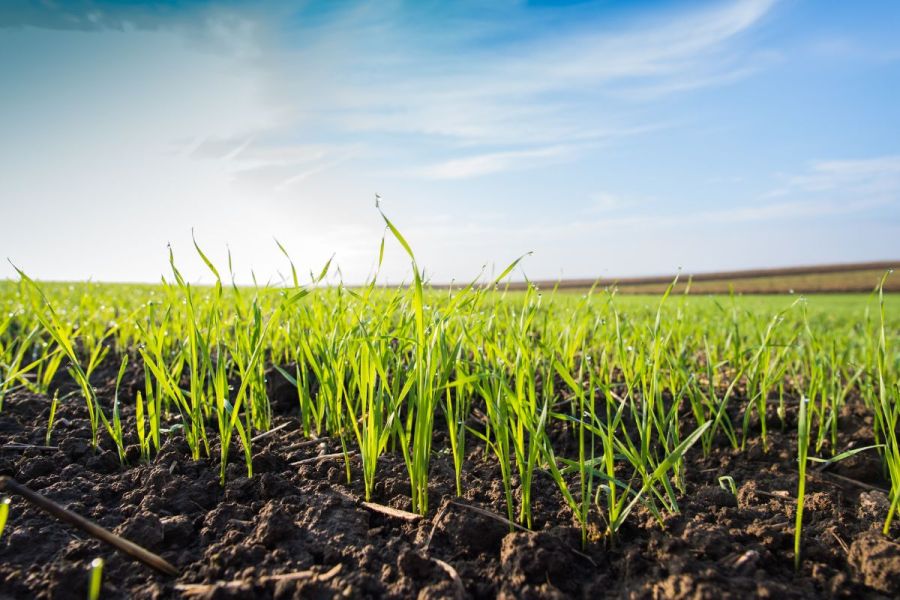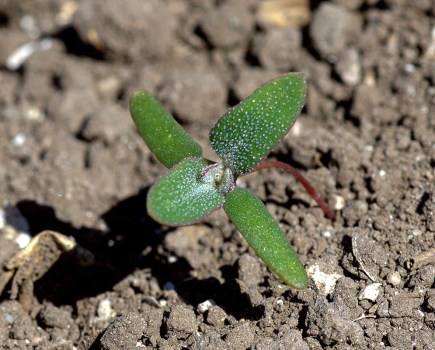In a year where cereal crops will be hungry thanks to suboptimal conditions, plus continued nervousness around conventional input prices and supply, interest in alternative products continues to rise. CPM learns how biostimulants can help when focusing on margin over yield.
“Helping crops at different growth stages and during situations such as stress or drought, is one of the ways to reach full crop potential.”
By Janine Adamson
According to agronomist Alice Clews, it’s time to focus on gross margins rather than yield alone. And to facilitate this switch in mindset, using all elements of the input armoury is required, particularly micronutrients and biostimulants.
Alice believes biostimulants will add significantly to the nutrient programmes being recommended on farms in the future. But rather than sit and wait for tomorrow, she’s already applying this philosophy to support farmer James Warren at Tall Oaks Farm in Huby, North Yorkshire.
Whereas his medium loam soils are mostly free draining and support a cereal rotation based on 100ha of first and second winter wheat, winter barley and oilseed rape, some of his lighter and sandy soils have presented a nutritional challenge.
For this aspect of his rotation, he integrates spring barley, and stubble turnips for sheep grazing – both important elements. To overcome the nutritional conundrum, James believes biostimulants – more specifically Crop Rooter Plus – help to improve available levels of essential nutrients and trace elements including phosphorus, sulphur, manganese, copper and boron.
“The timing flexibility of biostimulants is key. Helping crops at different growth stages and situations such as when under stress or in drought conditions, is one of the ways to reach full crop potential,” says James.
So what constitutes Crop Rooter Plus? In answer, the foliar product is a concentrated NPK phosphite feed formulated with 19 plant-derived amino acids. For the plant, this results in promoted root development leading to enhanced growth.
James agrees that phosphite has helped his cereal crops to develop better root mass, which in turn has allowed improved scavenging for soil-held nutrients further away from the plant. “We started using biostimulants last year and have been encouraged by their performance. It was our Velcourt Advisory agronomist Alice who recommended Crop Rooter Plus based on a number of years of independent trial data.”
Alice says her interest lies in the impact biostimulants can have on crop performance, especially those grown on light and drought-prone soils, as well as those that have a proportion of nutrition supplied organically.
“Certainly on James’ farm, where some of the lighter land can be quite nutrient hungry, we’ve seen encouraging results where Crop Rooter Plus has been applied. It now features in a wider range of nutritional regime recommendations I make,” she says.
For context, Tall Oaks Farm operates a mix of plough-based and minimum tillage cultivation techniques followed by a combination drill. All fields are rolled, particularly the lighter land, which according to James require consolidating to conserve moisture. Drilling starts in mid-September and ideally, all fields will have been rolled within 24 hours of drilling.
Spring nutrition involves winter wheat receiving 50kgN/ha at mid-late tillering, applied using an Amazone twin disc spreader. This is followed by a second application of 100kgN/ha at GS31 supplied as liquid digestate from a bioenergy plant. A third application of 50kgN/ha is applied in granular form at GS32-37.
Alice says soil testing is a key management tool to help assess nutritional requirements. “It has to be a routine operation on all farms,” she stresses. “Ideally taking place around February, when the soils start to warm up. Being consistent about the time that soil testing takes place is probably more important than the specific time at which you undertake it.
“Ensuring that macro-nutrition is correct is a fundamental building block of crop production, however, we’re seeing responses to some biostimulants even when macro-nutrition is correct. As a result, biostimulants are featuring more routinely in nutrition strategies and being included in programmes on farms.”
Velcourt has been investigating the impact of micronutrients on crops, with particular interest in the role that phosphite has on nutrient uptake, says Alice. “Evidence shows that applications of Crop Rooter Plus are increasing crop yields, which is likely to be associate with more efficient nutrient recovery.
“Furthermore, evidence suggests that phosphite applications are beneficial alongside some fungicides to improve their uptake,” she says. “And this is one of the reasons why we’ve been so impressed with Crop Rooter Plus when applied at 1.0 l/ha at T0. We apply it at the same time as fungicides and the manganese foliar spray.
“A second application of Crop Rooter Plus at 1.0 l/ha is applied between mid-tillering and flag leaf, depending on the ground conditions for travelling. It’s difficult to predict when the crop is most likely to respond to applications, but trials have shown a total application of 2.0 l/ha split over 2-3 timings within the spring is an effective strategy,” explains Alice.
Last year, James’ yields were above average which meant the impact of the biostimulant was less obvious. However, he says visually, the difference in colour between treated and untreated fields was significant, particularly when the weather turned hot and the crop was stressed.
“The main difference in our nutrition regime last year was the earlier timing of the nitrogen and the inclusion of micronutrients,” he says. “It’s clear to me that early applied nitrogen is better than delaying it. If we can improve the rooting, and especially where there’s a good level of available nitrogen in the soil, then we may be able to reduce the amount of nitrogen applied going forward but have greater Nitrogen Use Efficiency (NUE).
“Last year this was definitely the case and going forward, biostimulants will play an increasingly critical role in our nutritional management programme,” says James.
Alice agrees that the key to using biostimulants is to understand the requirement of the crop, and that their use will vary depending on the weather and the season.
“Biostimulants should be applied at the right time. Trials show that there’s frequently a benefit from using them, although this is usually less visible than the response seen from applying fungicides, for example,” she says.
“This is why there’s value in focusing on gross margins rather than yield alone, when relating it back to applied inputs; micronutrients and biostimulants are key components in this process.
“Of course they’ve only been taken more seriously in the last few years, mainly because rising nitrogen costs have left no option other than to consider alternatives.”
To crunch the numbers, Velcourt trials on winter wheat have demonstrated an average margin over input cost (MOIC) benefit of £92/ha where Crop Rooter Plus has been applied, based on a price of £180/t. “Having the capacity to undertake our own trial work and make our own independent assessment of products is key to Velcourt’s crop production philosophy,” says Technical Director Nick Anderson.
“However, assessing biostimulants present their own specific challenges. Often we’re trying to identify changes in yield or quality which are below the level of Least Significant Difference (LSD), which makes them hard to attribute to the application of the product, rather than to variation caused by different factors. In more than 40 trials over the last decade, this has always been the case.”
When the company first looked at Ilex EnviroSciences’ Crop Rooter Plus in 2019, Nick says they were surprised to observe something different. “In our first Crop Rooter Plus trial, six out of 12 treatments delivered a statistically significant increase in yield over the control, meaning that we could say with 95% statistical confidence that these yield increases were a result of the product’s application,” he explains.
Concerned that this could have been the consequence of a factor unique to either the site or season, Velcourt undertook a further five trials in subsequent seasons. “During the six trials, we are able to make 47 comparisons of Crop Rooter Plus applications with the untreated control, 41 of these resulted in a numerical increase in yield, two showed no change in yield, and four appeared to reduce the yield (by a maximum of 1.6%).
“An aggregated dataset of this nature, where the product has been looked at in three seasons on six different sites, provides a very high level of confidence in the response we have seen,” explains Nick.
As growers enter spring with trepidation following a challenging autumn, what role will Crop Rooter Plus play? Murray Smedley from Ilex EnviroSciences says scavenging for nutrients will be even more important than ever.
“Widespread waterlogging will mean nutrients will have been washed away and leached. Not only that, crops will potentially be quite backwards and hungry as a result,” he says.
In addition, Murray believes it’s the bioactive agents found in the product which ‘helps a plant to help itself’. “It’s all about combatting abiotic stresses which include anything from lack of sunlight to extreme temperatures.”
Nick concurs that although some growers may want to avoid further investing in poorly performing crops, for those who prefer to optimise what they do have, biostimulation is a valuable tool at hand. “As growth starts again in the spring, applying early nutrition including biostimulants will help to drive root biomass and promote tillering,” he says.
Already a convert, Flagleaf Farming’s Jim Beeden says he believes biostimulants such as Crop Rooter Plus are ‘here to stay’.
“The answers to disease control always used to be found in a can of pesticide, but with many key actives either being revoked or having lost potency, we’ve had to look elsewhere for solutions to make a crop more resilient to disease and better able to deal with stress pressure,” he says.
For the past four seasons, he’s used Crop Rooter Plus, and in the first year, he tested it against a range of other foliar nutrition and biostimulant products on the market.
Jim says he only saw a significant visual difference in crops where the Crop Rooter Plus had been applied, particularly with a larger root mass and healthier plants.
“We follow a simple programme based on two applications of 1.0 l/ha with ideally the first being applied in the autumn, but if the land won’t travel, then waiting until the spring is fine.”
The first application should be applied ideally at mid-tillering which coincides with T0, T1 timings. We leave 4-6 weeks between each application,” he explains.
Jim says as well as his own findings, he was impressed with the trial data from Velcourt. “Ilex is a company with numerous independent trials, so we’re confident that including Crop Rooter Plus in with our existing portfolio of products will continue to have a positive impact on cost effective crop performance.
“Biostimulants have a role but they must be proven. I think the ban on some fungicides and herbicides has created a requirement for a different line of thinking and plant health is the key,” says Jim.
Velcourt trials are now investigating the impact of Crop Rooter Plus on spring crops with promising results so far. “In 2023 we conducted six fully randomised and replicated trials for yield response in spring barley,” says Nick.
“Impressively, we saw a positive response in five out of six of the sites, which adds confidence in the product’s ability to deliver success in spring crops. Of course that’ll be particularly relevant given autumn challenges and switches in rotations,” he concludes.
This article was taken from the latest issue of CPM. Read the article in full here.
For more articles like this, subscribe here.
Sign up for Crop Production Magazine’s FREE e-newsletter here.




